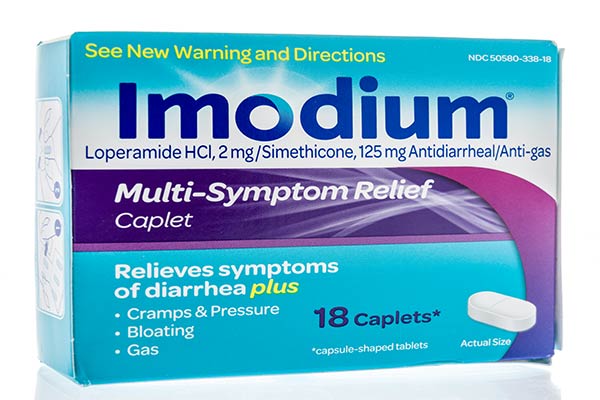Imodium, which contains the active ingredient loperamide, is an over-the-counter medication used to treat diarrhea. Since Imodium does bind to opioid receptors, at very high doses, it can cause some euphoria if it crosses the blood-brain barrier. It would take enormous amounts to feel an Imodium high, and some opioid addicts may take as many as 50 to 300 pills a day in order to achieve this. Loperamide is becoming increasingly abused by individuals that are using it to either self-treat opiate dependence or withdrawal symptoms or to achieve the euphoria associated with these drugs. It is being increasingly misused in proportions that, in the most extreme reported usage, exceed the recommended dosage by amounts as high as 25 to nearly 50 times. Loperamide’s (Imodium) accessibility as a low cost, over-the-counter medicine, and lack of social stigma associated with its use contribute to its potential for abuse. Some people may unknowingly stumble into this misuse as they take the drug to treat constipation which is one of the most common side effects of opiate withdrawal. In the process of taking the drug for this purpose, they may begin adjusting the dosage on their own accord as they find that the drug is moderating other withdrawal symptoms as well. Currently, there are little restrictions on the amount of this drug that an individual can buy. For this reason, people can take this medication in large proportions in an attempt to mimic the effect of other opiate-based drugs. 
What are the Risks of Abusing Imodium?
The opioid epidemic is one of the biggest disease epidemics in history and it’s the most significant illicit drug-abuse crisis in modern times. An opioid is a highly addictive class of drugs that includes prescription painkillers, heroin, and synthetic analogs like fentanyl. The crisis is currently raging across the United States, so much so that President Trump declared the opioid epidemic a Public Health Emergency in 2017. The opioid crisis as radiated out to other points of concern beyond opioid addiction and overdose. In areas that are plagued by opioid addiction, crime rates, prostitution, violence, and infectious diseases also increase. Recently, officials have noticed a new consequence of the crisis. People are using the over-the-counter drug Imodium to get high and treat opioid withdrawal symptoms.
Can Imodium Be Used for Opioid Withdrawal?
The FDA now requires that Imodium packaging have a warning on the label that informs consumers about the potentially dangerous effects of misuse. The FDA recommends only allowing enough Imodium for short-term use to be sold over the counter as now the drug is approved for a maximum of 8 mg per day in over-the-counter strengths and 16 mg per day in prescriptions. Like most medications, Imodium comes with a standard set of side effects that can come from regular use of the drug, which becomes worse if you take exceedingly high doses. There are also a few rare side effects that are more serious and may require medical attention. Rare side effects typically occur in people who have contraindications like people who are hypersensitive to Imodium, patients who have certain gastrointestinal issues like ulcers, and infants. However, rare and dangerous side effects may be more likely in people who abuse the drug. Some of the normal side effects are constipation, dizziness, nausea, and abdominal cramps. Some of the more serious side effects are life-threatening cardiac arrhythmias, toxic megacolon (dilated colon with bloating and abdominal pain), various skin conditions, urinary retention, heatstroke, swelling around the eyes, and paralytic ileus (intestines stop pushing material through). In most cases, abnormal cardiac symptoms return to normal when a patient stops using the drug.


